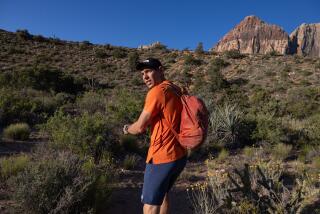Cyclist, Once Paralyzed, Rolls Onward
- Share via
OJAI — After a car accident more than 40 years ago, doctors told Lee Fitzgerald that he probably would spend the rest of his life stuck on wheels.
In a way, he has.
But not in a wheelchair. After years of physical therapy, Fitzgerald, 57, can walk--but perhaps more importantly, he can ride, pedaling the recumbent bicycle that keeps him low to the ground and slipping through the neighborhood streets of this mountain town.
And now, his everyday bicycle route is about to get much longer.
Fitzgerald--who has already made road trips to Santa Barbara, across Death Valley and to San Francisco--has set his sights on the lights of Las Vegas, a trip he plans to start Nov. 21, in a three-day trek through the desert.
He hopes to draw attention to such issues as homelessness and domestic violence, Fitzgerald said, but it seems as likely that he wants to prove to himself that he can do it.
It doesn’t seem like much of a stretch. Fitzgerald’s life reads like a checklist of challenges overcome: the Lockwood Valley car accident in 1956 that killed a fellow Villanova High School football player and left Fitzgerald paralyzed from the waist down; the drug problem that plagued him during a short L.A. music career; the stint as a drug and alcohol counselor; the hard ride across Death Valley, under a merciless sun and against a relentless wind.
He started in a wheelchair--the bar he used to lift himself still hangs in the Ojai home where he grew up and now lives. He graduated to crutches and then ditched those for a cane. Now, the only support he needs is a metal brace that fits into the back of his moccasins and leaves him with a slight limp.
“There are limits, but you can get past the limits with the right mind-set,” Fitzgerald said.
Now middle-aged, with a tail of graying hair and a crinkle-eyed smile, he is keen on having the right mind-set. He’s conversant in the language of self-help. He’s the kind of guy who won’t say “can’t,” who always has a plan, who looks to the future and who sees endless opportunities.
“Most people give up. He doesn’t,” said April Rogers, his girlfriend of five years and a nonstop Lee Fitzgerald booster. Together, they are a virtual two-person cottage industry: social workers intent on helping out a poor Palmdale family, filmmakers who regularly air their work on public access, planners of ambitious bicycle trips.
Fitzgerald rides. Rogers drives the van nearby, ready to toss an “I love you” hand sign out the window signaling that everything is going as it should. The chirpy redhead is Fitzgerald’s right-hand woman, always ready to jump in and clarify a story, jog a memory, focus a point.
He owns several bicycles, but the recumbent is the attention-getter--a feather-light skeleton of a bicycle that speeds roadrunner-like down Ojai’s hills. When Fitzgerald gets started, “the thing just flies,” he said.
And it hasn’t been easy. At early bike races, Fitzgerald drew jokes from young bicyclists who whipped past him on their upright bikes. But as his story got out, as riders realized that he has no feeling below his right knee, they changed, Rogers said.
“They cheered for him. He would get the biggest applause of anybody,” she said.
He earned a California Triple Crown award, for three 200-mile races, including the Death Valley trip. He was awarded a certificate from the Ojai Bicycle Coalition for promoting biking in Ojai.
He has spent weeks preparing for this trip to Vegas. He and Rogers made a practice run in the van, to confirm the route and get a sense for the winds. He outfitted his bike with a comfortable seat.
There’s something ironic, Fitzgerald says, about a man who once had problems with drugs and alcohol riding into Las Vegas. He can cycle through the Strip, his own version of the conquering hero.
“I’ll ride in over the mountains and through the desert,” Fitzgerald said. “And then it will just be me on my bike, surrounded by thousands of glittering lights. It will be beautiful.”
Times staff writer Catherine K. Enders contributed to this report.
More to Read
Sign up for Essential California
The most important California stories and recommendations in your inbox every morning.
You may occasionally receive promotional content from the Los Angeles Times.













